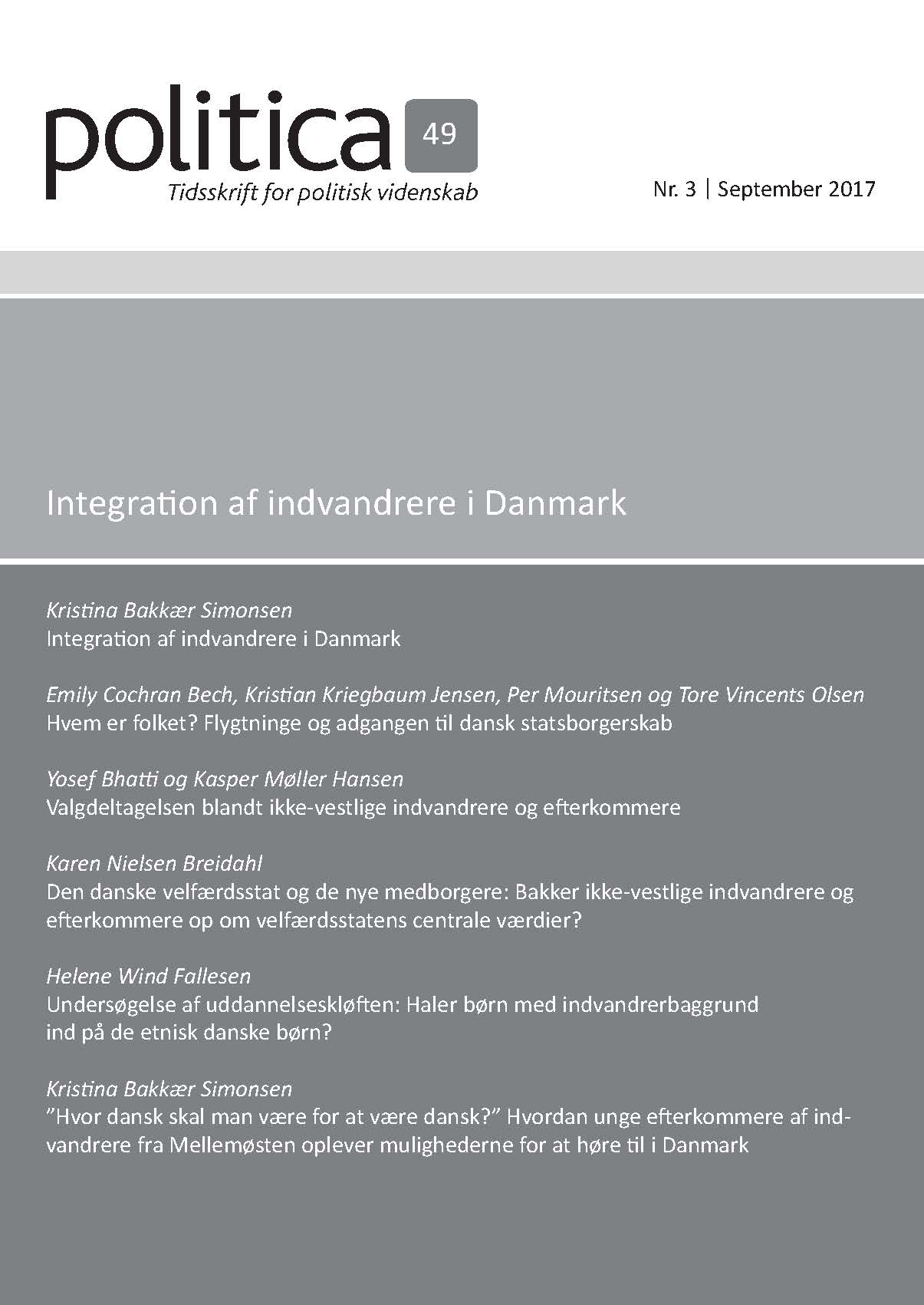Undersøgelse af uddannelseskløften: Haler børn med indvandrerbaggrund ind på de etnisk danske børn?
DOI:
https://doi.org/10.7146/politica.v49i3.131252Resumé
Hvorfor eksisterer der en uddannelseskløft mellem etnisk danske børn og børn med indvandrerbaggrund fra ikke-vestlige lande? Og er kløften blevet reduceret over tid? Denne artikel bidrager til den eksisterende danske forskning ved at undersøge, hvad der kan forklare uddannelseskløftens eksistens samt kløftens udvikling over tid. Uddannelseskløften undersøges ved at sammenligne gennemførelsesprocenten på ungdomsuddannelser for børn, der har færdiggjort 9. klasse i 1990 til 2007. Uddannelsesproduktionsfunktionen estimeres som en lineær sandsynlighedsmodel med OLS. Artiklen finder, at uddannelseskløften er blevet reduceret over de seneste 20 år, og at forskelle i familiebaggrund forklarer en stor del af kløften. Yderligere findes en stærk sammenhæng mellem barnets alder på indvandringstidspunktet og uddannelsesmæssig præstation.
Referencer
Adli, Rhonya, Ahmed Louichi og Nadia Tamouh (2010). The sibling size impact on the educational achievement in France. Education Economics 18 (3): 331-348.
Angrist, Joshua David og Jörn-Steffen Pischke (2009). Mostly Harmless Econometrics: An Empiricist’s Companion. Princeton: Princeton University Press.
Bratsberg, Bernt, Oddbjørn Raaum og Knut Røed (2012). Educating children of immigrants: Closing the gap in Norwegian schools. Nordic Economic Policy Review 211-251.
Böhlmark, Anders (2008). Age at immigration and school performance: A siblings analysis using Swedish register data. Labour Economics 15: 1366-1387.
Colding, Bjørg, Leif Husted og Hans Hummelgaard (2009). Educational progression of second-generation immigrants and immigrant children. Economics of Education Review 28: 434-443.
Danmarks Statistik (2014). Statistisk årbog. København: Rosendahls-Schultz Grafisk A/S.
Deding, Mette og Mohammad Azhar Hussain (2005). Educational attainment in Denmark: The role of parents’ education and childhood living conditions. Journal of Applied Aocial Science Studies 125 (3): 1008-1019.
Dickson, Matt, Paul Gregg og Harriet Robinson (2013). Early, late or never? When does parental education impact child outcomes? IZA Discussion Paper (7123).
Dustmann, Christian, Tommaso Frattini og Gianandrea Lanzara (2012). Educational achievement of second-generation immigrants: an international comparison. Economic Policy 69 (69): 143-185.
Hanushek, Eric Alan (1973). Education and Race: An Analysis of the Educational Production Process (2. udg.). Lexington: Lexington Books.
Hanushek, Eric Alan (1979). Conceptual and empirical issues in the estimation of educational production function. The Journal of Human Resources 14 (3): 351-388.
Jakobsen, Vibeke og Nina Smith (2006). The educational attainment of the children of the Danish “guest worker” immigrants. Danish Journal of Economics 144 (2): 18-42.
Machin, Stephen og Sandra McNally (2005). Gender and student achievement in English schools. Oxford Review of Economic Policy 21 (3): 357-372.
Rangvid, Beatrice Schindler (2007). Sources of immigrants’ underachievement: Results from PISA-Copenhagen. Education Economics 15 (3): 293-326.
Rangvid, Beatrice Schindler (2010). Source country differences in test score gaps: Evidence from Denmark. Education Economics 18 (3): 269-295.
Riphahn, Regina Therese (2003). Cohort effects in the educational attainment of second generation immigrants in Germany: An analysis of census data. Journal of Population Economics 16 (4): 711-737.
Schneeweis, Nicole (2011). Educational institutions and the integration of migrants. Journal of Population Economics 24 (4): 1281-1308.
Schou, Poul (2006). Immigration, integration and fiscal sustainability. Journal of Population Economics 19 (4): 671-689.
Støren, Liv Anne og Håvard Helland (2010). Ethnicity differences in the completion rates of upper secondary education: How do the effects of gender and social background variables interplay? European Sociological Review 26 (5): 585-601.
Todd, Petra Elisabeth og Kenneth Wolpin (2003). On the specification and estimation of the production function for cognitive achievement. The Economic Journal, 113 (485): F3-F33.
Todd, Petra Elisabeth og Kenneth Wolpin (2007). The production of cognitive achievement in children: Home, school, and racial test score gaps. Journal of Human Capital 1 (1): 91-136.
Van Ours, Jan og Justus Veenman (2006). Age at immigration and educational attainment of young immigrants. Economic Letters 90 (3): 310-316.
Velfærdsaftalen (2006). Aftale mellem regeringen (Venstre og Det Konservative Folkeparti) og Socialdemokraterne, Dansk Folkeparti og Det Radikale Venstre om initiativer til sikring af fremtidens velstand og velfærd og investeringer i fremtiden. https://www.fm.dk/publikationer/2006/aftale-om-fremtidens-velstand-og-velfaerd
Weinberg, Bruce (2001). An incentive model of the effect of parental income on children. Journal of Political Economy 109 (2): 266-280.
Wooldridge, Jeffrey (2003). Introductory Econometrics: A Modern Approach (2. udg.). Australia: Thomson/South-Western.
Wooldridge, Jeffrey (2010). Econometric Analysis of Cross Section and Panel Data (2. udg.). Cambridge: the MIT press.
Downloads
Publiceret
Citation/Eksport
Nummer
Sektion
Licens
LicensOphavsretten tilhører Politica. Materialet må ikke bruges eller distribueres i kommercielt øjemed.





